Hua C., Wong R. Differential Equations and Asymptotic Theory in Mathematical Physics
Подождите немного. Документ загружается.


52
We can dream of a “good summation” theory which will allow us to
invert the Taylor map
J:
SUM
:
@[[XI]
4
d(V)
Unfortunately the “error space”
d‘’(V)
is an LL~b~tr~~tion77 to the ex-
istence of such a map. Therefore we are naturally led to the following
problems, which must be related to domains of application.
Question
1.1.
Reduce the “error space” to
a
space
as
small as possible of
“unavoidable small corrections”.
Question
1.2.
Reduce the “error space” to the ZERO SPACE and get
a
theory of EXACT ASYMPTOTICS.
We will essentially solve these two problems. The first step will be from
Poincark Asymptotics to Gevrey Asymptotics (Question 1.1)). The second
step will be from Gevrey Asymptotics to Exact Asymptotics (Question 1.2).
We will see that Gevrey Asymptotics is quite universal in the applica-
tion~~. The domain of application of exact asymptotics is extremely large
(Singular analytic ordinary differential equations and partial differential
equations, normal forms, algebraic quantum oscillators
.
..),
however such
asymptotics are not the rule for interesting domains like singular pertur-
bations or averaging problems. In such domains these exist in general non
trivial unavoidable exponentially flat small corrections.
In these notes we will present mainly our personal viewpoint about mat-
ters like Gevrey Asymptotics and Exact Asymptotics, but it is important
to notice that many theories have been developed during the last 25 years
by various schools:
Resurgence Theory
(J.
Ecalle and after him
F.
Pham and coworkers
Exponential asymptotics
(M.
Kruskal,
0.
Costin,
. .
.
)
Hyperasymptotics
(M.
Berry, Howles,.
. .
)
All these approaches are strongly interrelated and are in fact different
aspects of a
same theory
which is strongly emerging, with a lot of beautiful
applications. Here we will limit ourselves to an
elementary
presentation.
like
E.
Delabaere,
D.
Sauzin
.
. .
)
4There are some exceptions like q-difference equations
[24]
but in such cases,
we
can
use
adapted generalizations
[35].
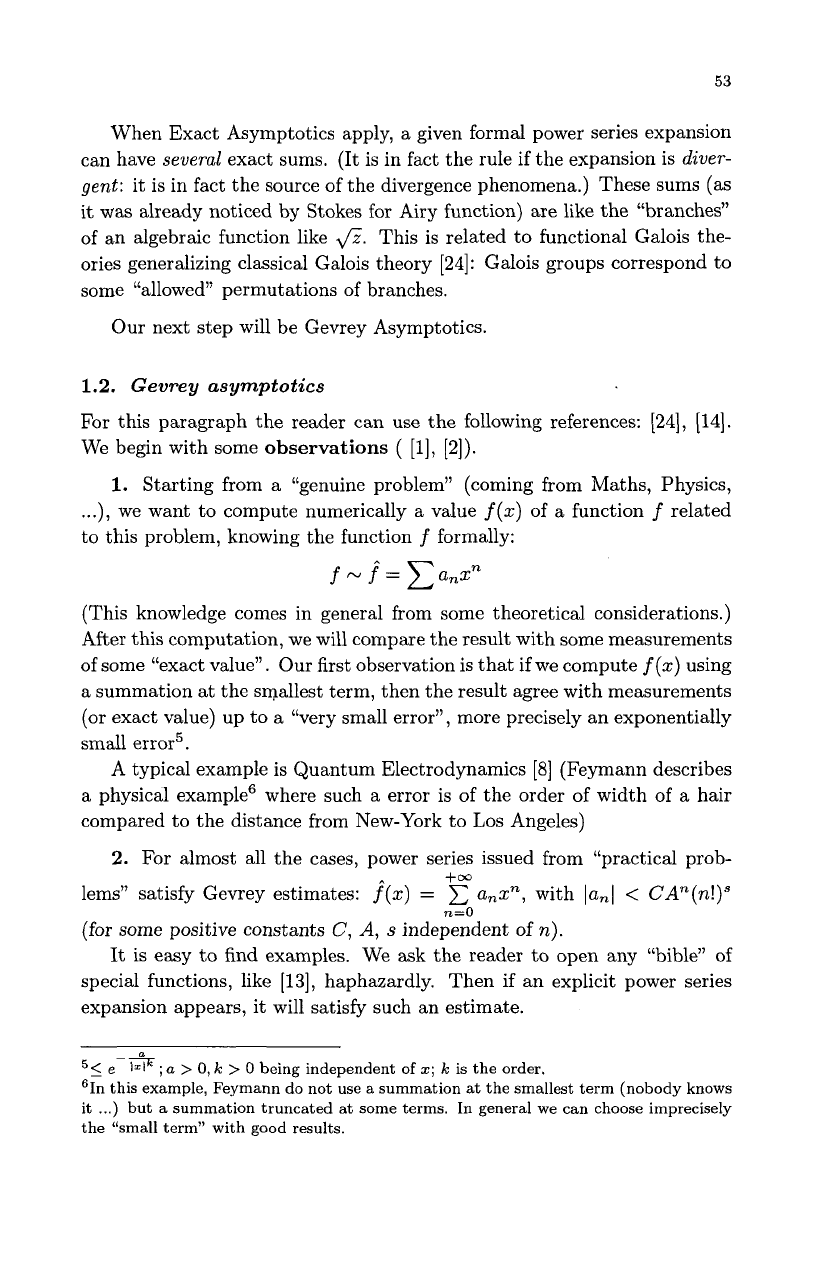
53
When Exact Asymptotics apply, a given formal power series expansion
can have
several
exact sums.
(It
is in fact the rule if the expansion is
diver-
gent:
it is in fact the source of the divergence phenomena.) These sums (as
it was already noticed by Stokes for Airy function) are like the “branches”
of an algebraic function like
fi.
This is related to functional Galois the-
ories generalizing classical Galois theory
[24]
:
Galois groups correspond to
some
“allowed” permutations of branches.
Our next step will be Gevrey Asymptotics.
1.2.
Gevrey asyrnptotics
For this paragraph the reader can use the following references:
[24], [14].
We begin with some
observations
(
[l], [2]).
1.
Starting from a “genuine problem” (coming from Maths, Physics,
...),
we want to compute numerically a value
f
(x)
of
a
function
f
related
to this problem, knowing the function
f
formally:
(This knowledge comes in general from some theoretical considerations.)
After this computation, we will compare the result with some measurements
of some “exact value”. Our first observation is that if we compute
f
(x)
using
a summation at the smallest term, then the result agree with measurements
(or exact value) up to a “very small error”, more precisely an exponentially
small error5.
A
typical example is Quantum Electrodynamics
[8]
(Feymann describes
a physical example6 where such a error is of the order of width of
a
hair
compared to the distance from New-York to
Los
Angeles)
2.
For almost all the cases, power series issued from “practical prob-
lems” satisfy Gevrey estimates:
f(x)
=
C
unxn,
with
lan[
<
CA”(n!)”
(for some positive constants
C,
A,
s
independent
of
n).
It
is easy to find examples. We ask the reader to open any “bible”
of
special functions, like
[13],
haphazardly. Then if an explicit power series
expansion appears, it will satisfy such an estimate.
+m
n=O
5<
-
e-1.i”
;
a
>
0,
k
>
0
being independent
of
I;
k
is the order.
61n this example, Feymann do not use a summation
at
the smallest term (nobody knows
it
...)
but
a
summation truncated at some terms. In general we can choose imprecisely
the “small term” with good results.

54
3.
In “practical problems”, if knowing a power series expansion
f,
there
are some (theoretical or numerical) ambiguities on the corresponding actual
function, then these ambiguities have an exponential decay (of some order
k
>
0),
when
z
-+
0,
lv(x)l
5
Ke-*
(K,
a
>
0
independent of
z).
Considering these three observations, it is natural to try to replace
Poincark Asymptotics by a new asymptotic theory explaining
1,
2,
3.
The
good news is that such
a
theory exists: it is Gevrey Asymptotics. In fact
“more or less”:
1
2
3
we are in the case of Gevrey Asymptotics.
Gevrey Asymptotics were discovered by G. Watson at the beginning of
the XXth century. But unfortunately it meet more
or
less no success and
was forgotten.
I
rediscovered it (and gave it its name
...,
in relation with
M.
Gevrey work on partial differential equation
)
at
the end of the
~O’S,
and developed it systematically in relation with the applications
[24].
G. Watson’s work was rejected because mathematicians was thinking
that its field of applications was extremely narrow. (G. Watson applied his
theory only to some special functions: r-function, Bessel functions
...
).
In
fact,
as
I
will explain later, its field of application is today extremely large,
containing whole families of analytic functional equations (ordinary differ-
ential equations: without restrictions, singular perturbations of ordinary
differential equations, some problems of partial differential equations
. ..
).
If
G. Watson’s work
was
forgotten for a long time, it
is
worth to notice that
there is however
a
“red thread” going from G. Watson to
S.
Mandelbrojt
(though some works of
R.
Nevanlinna, Carleman and Denjoy).
Gevrey asymptotics is an essential step towards exact asymptotics.
Moreover it is exactly the good asymptotics for singular perturbations and
it allows us to understand phenomena like delay in bifurcations, ducks phe-
nomena, Ackerberg-O’Malley resonance,
.. .
or perturbations of Hamilto-
nian systems (adiabatic invariants, Nekhorosev estimates,
...)
I
will begin with my favorite example (Euler series):
n=O
It
was introduced by
L.
Euler in his paper ‘LDe seriebus divergentibus”. His
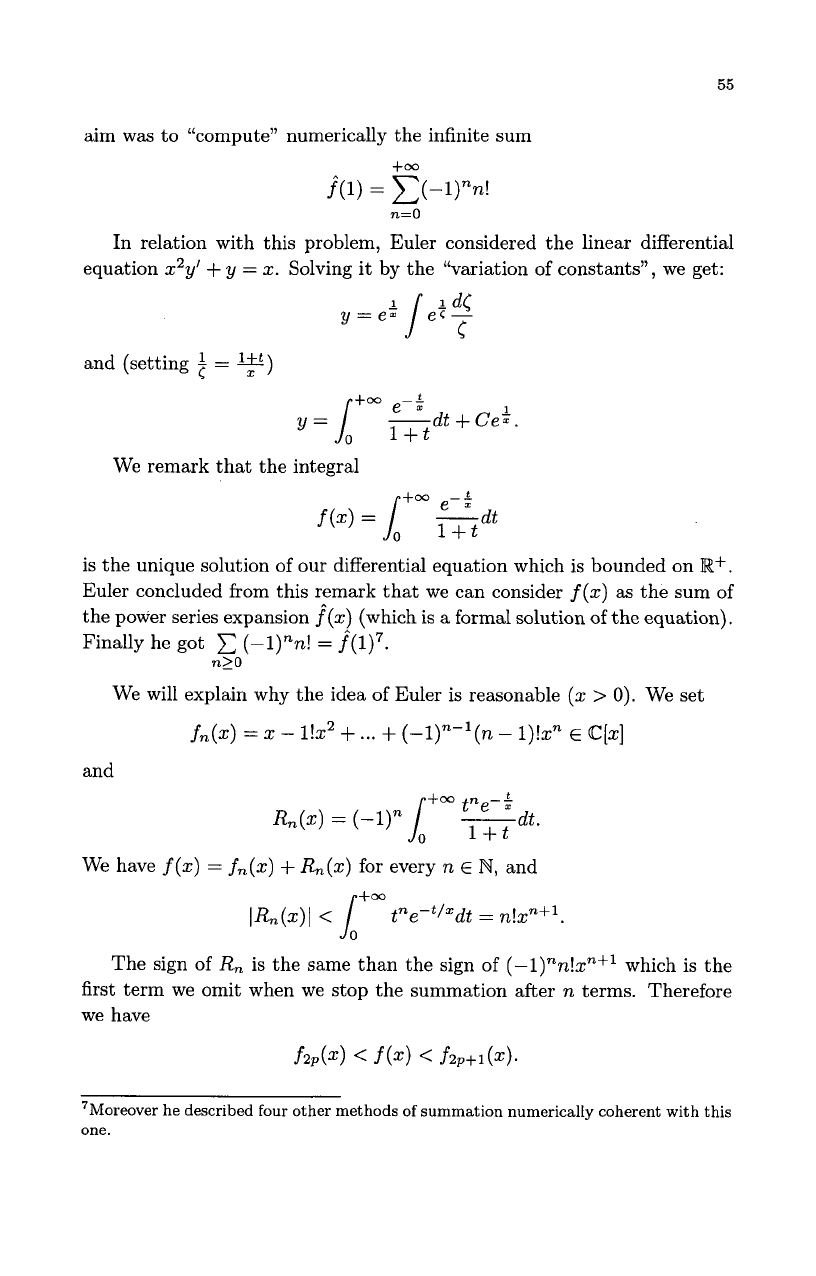
55
aim was to "compute" numerically the infinite sum
+m
,
--
j(1)
=
C(-l)"n!
n=O
In relation with this problem, Euler considered the linear differential
equation
x'y'
+
y
=
x.
Solving it by the "variation of constants", we get:
and (setting
$
=
5)
-dt
+
Ceh.
We remark that the integral
is the unique solution of our differential equation which is bounded on
R+.
Euler concluded from this remark that we can consider
f(x)
as
the sum
of
the power series expansion
f(z)
(which
is
a
formal solution
of
the equation).
Finally he got
C
(-1)".n!
=
f"(l)'.
n20
We will explain why the idea of Euler is reasonable
(x
>
0).
We set
fn(z)
=
2
-
1!x2
+
...
+
(-l)n-l(n
-
l)!?
E
@[.I
and
+m
tne-;
Rn(2)
=
(-1)n
1
l+tdt.
We have
f(x)
=
fn(x)
+
Rn(z)
for every
n
E
N,
and
IRn(x))
<
tne-t/xdt
=
n!xn+'.
The sign of
R,
is the same than the sign of
(-l)"n!xnf'
which is the
first term we omit when we stop the summation after
n
terms. Therefore
we have
7Moreover he described four other methods of summation numerically coherent with this
one.
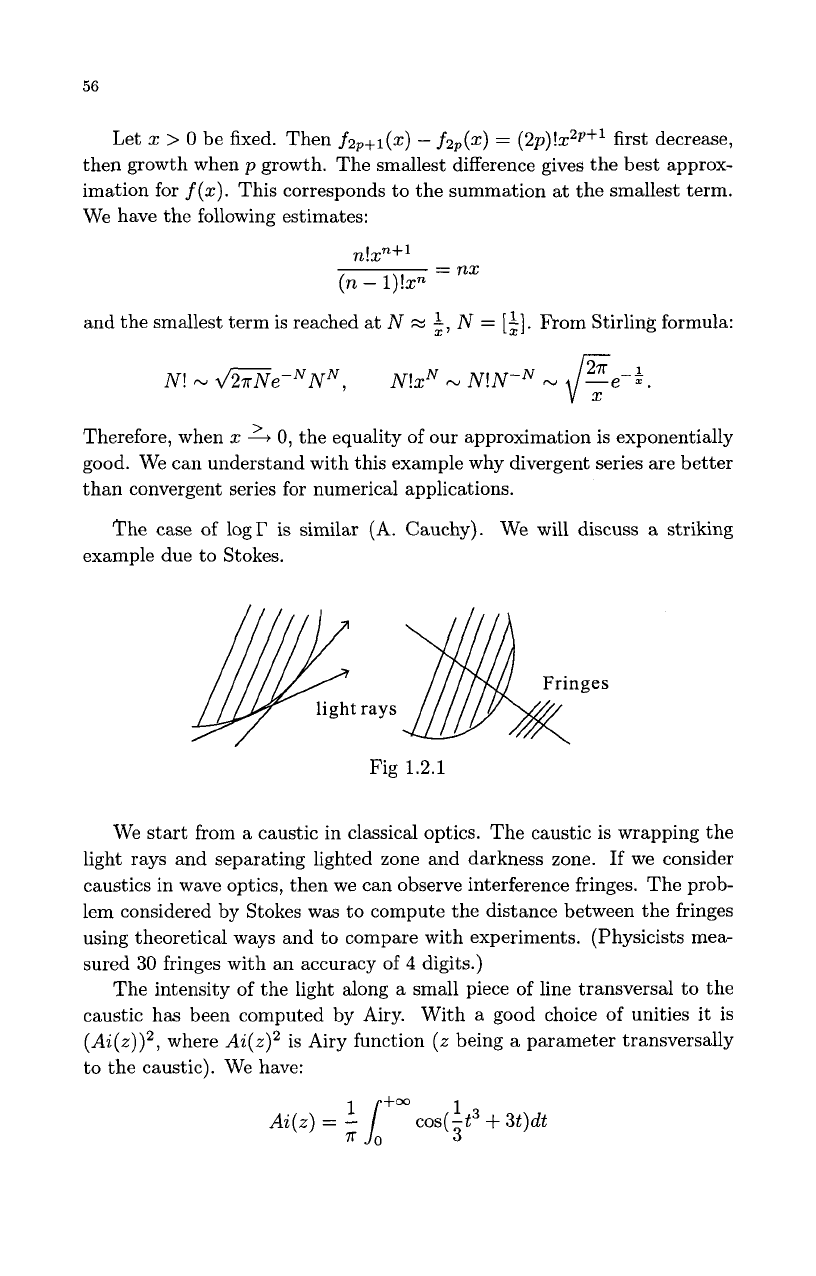
56
Let
x
>
0
be fixed. Then
f2p+1(z)
-
f2,(z)
=
(2p)!z2Y+l
first decrease,
then growth when
p
growth. The smallest difference gives the best approx-
imation for
f(z).
This corresponds to the summation at the smallest term.
We have the following estimates:
n!xn+l
(n
-
l)!zn
=
nx
and the smallest term is reached
at
N
M
$,
N
=
[$I.
From Stirling formula:
Therefore, when
x
5
0,
the equality of our approximation is exponentially
good. We can understand with this example why divergent series are better
than convergent series for numerical applications.
The case of logr is similar (A. Cauchy). We will discuss
a
striking
example due to Stokes.
~ light
rays
Fig
1.2.1
We start from a caustic in classical optics. The caustic is wrapping the
light rays and separating lighted zone and darkness zone.
If
we consider
caustics in wave optics, then we can observe interference fringes. The prob-
lem considered by Stokes was to compute the distance between the fringes
using theoretical ways and to compare with experiments. (Physicists mea-
sured
30
fringes with an accuracy
of
4
digits.)
The intensity of the light along a small piece of line transversal to the
caustic has been computed by Airy.
With a good choice
of
unities it is
(A~(z))~,
where
AZ(Z)~
is Airy function
(z
being a parameter transversally
to the caustic). We have:
1
IT
3
fa
~i(~)
=
1
cos(-t3
+
3t)dt

57
and this function is a solution of the Airy's equation
y"
-
zy
=
0.
Airy function admits a convergent asymptotic expansion at the origin
z
=
0:
Airy tried to compute the fringes using this convergent expansion.
only get one fringe (with
4
digits).
He could
Conversely to Airy, Stokes used expansions
at
infinity
(z
=
00).
Using
stationary phases method, we get the expansion
The power series appearing in this expansion is clearly divergent. How-
ever, using this expansion and summation at the smallest term (in fact an
improved version), Stokes was able to compute all the
30
fringes with an
accuracy of
4
digits, compared with physical experiments. (He failed only
for the first fringe: he got only
3
digits...). We can see on this example the
apparition of Gevrey estimates and exponentially small functions.
Returning back to this example several years later, Stokes discovered
what is called today Stokes Phenomenon (March
17,
1857,
three a.m.; cf.
~41).
We will give now some precise definitions.
Definition
1.2.
Let
V
be an open sector of
C
(with its vertex
at
the
origin). Let
f
E
O(V).
Let
f^
E
@[[XI]
and
s
E
R.
We will say that
f
is asymptotic to
f^
in Gevrey order
s
sense, if, for every strict subsector
W
4
V,
there exists positive constants
CW
>
0
and
AW
>
0
such that, for
every
n
E
N,
z
E
W:
n-1
1~1-"lf(z)
-
C
aPzPI
5
c~Ab(n!)~.
p=o
We will denote
f^
E
C[[z]ls
and
f
E
d,(V).
Remark
1.1.
0
If
s
=
0,
then
f
E
Cz:
f^
is convergent and conversely.
entire function with an exponential growth order
5
k
at
00.
0
If
s
<
0,
we set
s
=
-i(k
>
0).
Then
f
E
C[[z]ls
if and only iff is an
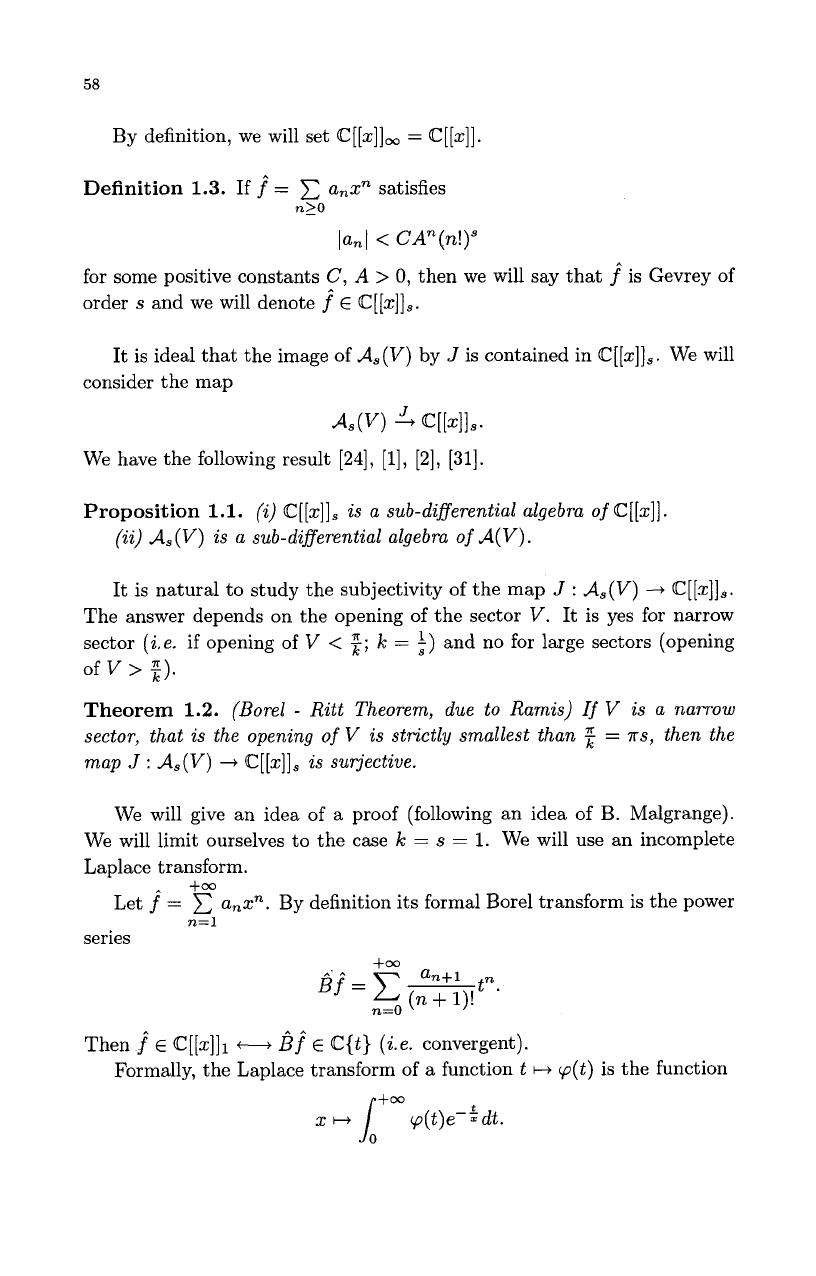
58
By definition, we will set
@[[z]lm
=
@[[XI].
Definition
1.3.
Iff
=
C
anzn
satisfies
n20
lan[
<
CA"(n!)"
for some positive constants
C,
A
>
0,
then we will say that
f
is Gevrey of
order
s
and we will denote
f^
E
@[[XI],.
It
is ideal that the image of
d,(V)
by
J
is contained in
@[[z]],.
We will
consider the map
A,(V)
@[[zlIs.
We have the following result
[24],
[l],
[2],
[31].
Proposition
1.1.
(i)
@[[z]],
is a sub-differential algebra
of
@[[z]].
(ii)
d,(V)
is a sub-differential algebra
of
d(V).
It
is natural to study the subjectivity of the map
J
:
d,(V)
-,
@[[x]],.
The answer depends on the opening of the sector
V.
It
is yes for narrow
sector
(ie.
if opening
of
V
<
f;
Ic
=
t)
and no for large sectors (opening
of
v
>
f).
Theorem
1.2.
(Borel
-
Ritt Theorem, due to Ramis)
If
V
is a narrow
sector, that is the opening
of
V
is strictly smallest than
f
=
TS,
then the
map
J
:
d,(V)
@[[z]],
is surjective.
We will give an idea of a proof (following an idea of B. Malgrange).
We will limit ourselves to the case
Ic
=
s
=
1.
We will use an incomplete
Laplace transform.
+m
n=l
Let
f
=
an9.
By definition its formal Borel transform is the power
series
t".
Sf=C-
an+l
(n
+
l)!
n=O
Then
f
E
@[[z]]~
-
Sf
E
@{t}
(i.e.
convergent).
Formally, the Laplace transform
of
a
function
t
H
p(t)
is the function
+m
z
H
cp(t)e-$dt.
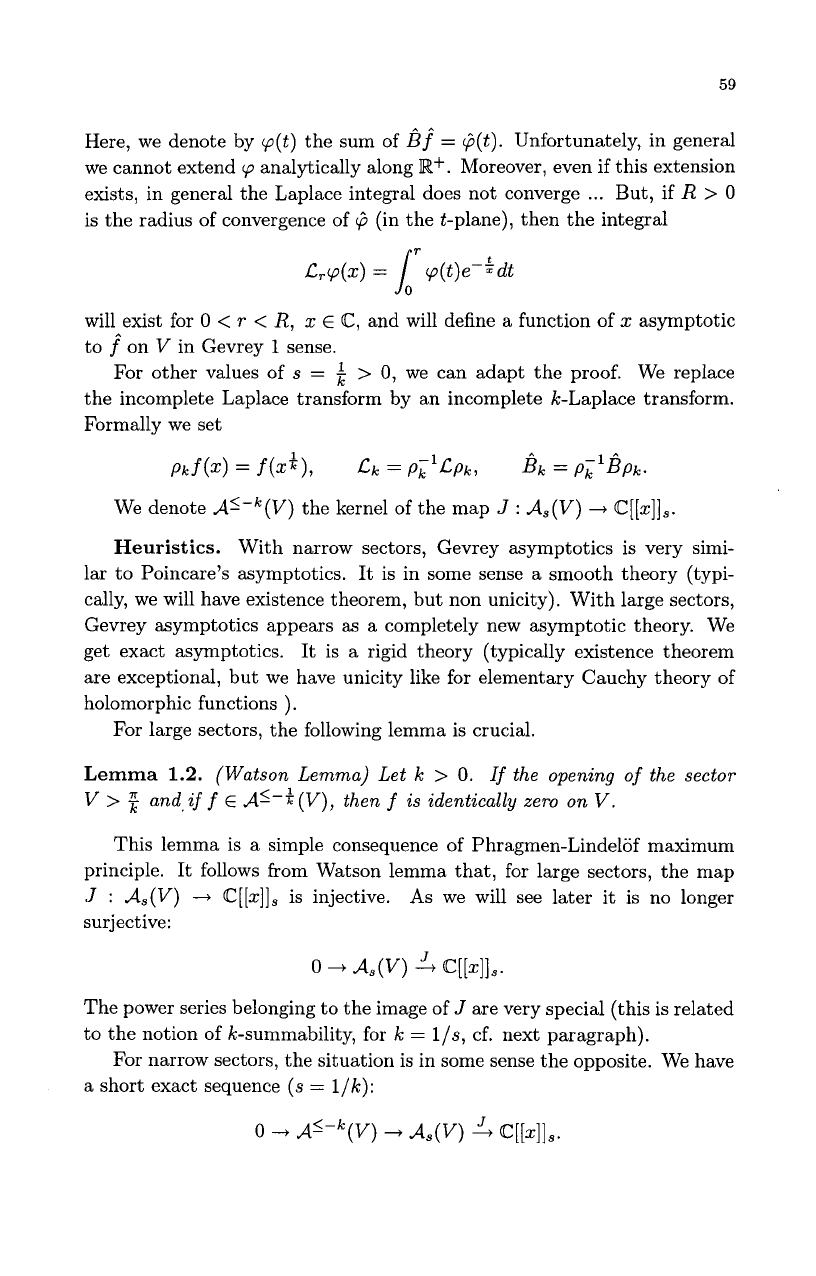
59
Here, we denote by
cp(t)
the sum of
Bf
=
@(t).
Unfortunately, in general
we cannot extend
'p
analytically along
Rf.
Moreover, even if this extension
exists, in general the Laplace integral does not converge
...
But, if
R
>
0
is the radius of convergence of
@
(in the t-plane), then the integral
will exist for
0
<
r
<
R,
z
E
C,
and will define a function of
z
asymptotic
to
f
on
V
in Gevrey
1
sense.
>
0,
we can adapt the proof. We replace
the incomplete Laplace transform by an incomplete k-Laplace transform.
Formally we set
For other values of
s
=
pkf
(z)
=
f(.'),
Lk
=
Pi
'Lpk, Bk
=
PL'Bpk.
We denote
AS-'"(V)
the kernel of the map
J
:
A,(V)
+
@[[z]],.
Heuristics.
With narrow sectors, Gevrey asymptotics is very simi-
lar to Poincare's asymptotics. It is in some sense a smooth theory (typi-
cally, we will have existence theorem, but non unicity). With large sectors,
Gevrey asymptotics appears
as
a completely new asymptotic theory. We
get exact asymptotics. It is a rigid theory (typically existence theorem
are exceptional, but we have unicity like for elementary Cauchy theory of
holomorphic functions
).
For large sectors, the following lemma is crucial.
Lemma
1.2.
(Watson Lemma) Let
k
>
0.
If
the opening
of
the sector
V
>
i
and,if
f
E
A'-i(V),
then
f
is identically zero on
V.
This lemma is a simple consequence of Phragmen-Lindelof maximum
principle. It follows from Watson lemma that, for large sectors, the map
J
:
A,(V)
--f
@[[XI],
is injective.
As
we will see later it is no longer
surjective:
0
4
A,(V)
@.[[z]],.
The power series belonging to the image of
J
are very special (this is related
to the notion of k-summability, for
k
=
l/s,
cf. next paragraph).
For narrow sectors, the situation is in some sense the opposite. We have
a
short exact sequence
(s
=
l/k):
0
---f
A'-k (V)
+
UV)
5
@[[z1ls.
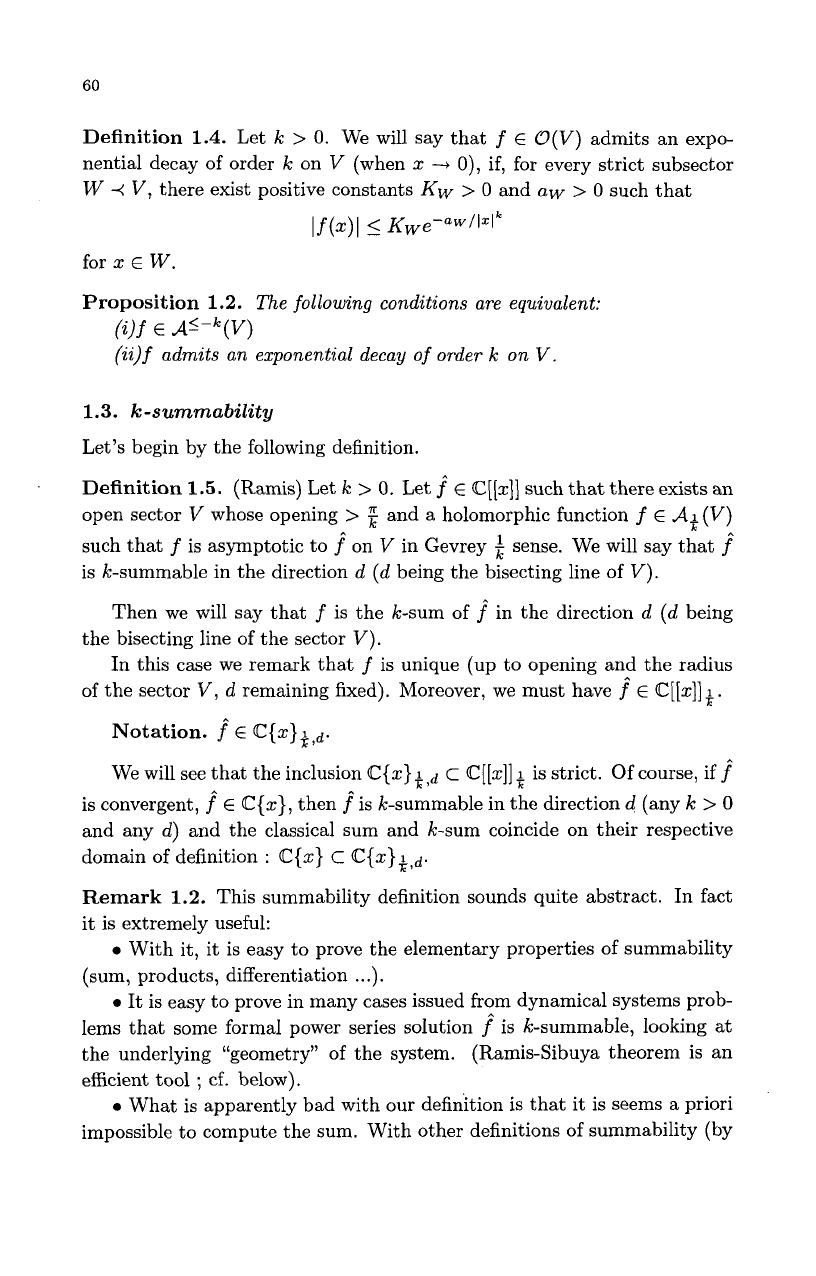
60
Definition
1.4.
Let
k
>
0.
We will say that
f
E
O(V) admits an expo-
nential decay of order
k
on V (when
2
-+
0),
if, for every strict subsector
W
+
V, there exist positive constants
Kw
>
0
and
aW
>
0
such that
I
f(.)I
5
KWe-awllzlk
for
2
E
W.
Proposition
1.2.
The following conditions are equivalent:
(i)f
E
d<-‘(V)
(ii)f
admits an exponential decay
of
order
k
on
V.
1.3.
k-summability
Let’s begin by the following definition.
Definition
1.5.
(Ramis)
Let
k
>
0.
Let
f^
E
@.[[%I]
such that there exists an
open sector
V
whose opening
>
i
and a holomorphic function
f
E
d+(V)
such that
f
is asymptotic to
f
on V in Gevrey sense. We will say that
f^
is k-summable in the direction
d (d
being the bisecting line of V).
Then we will say that
f
is the k-sum of
f^
in the direction
d (d
being
In this case we remark that
f
is unique (up to opening and the radius
Notation.
f
E
C{X}~,~.
We will see that the inclusion
@{x}$,~
c
C[[x]];
is strict. Of course, if
f^
is convergent,
f
E
C{z},
then
f^
is k-summable in the direction
4
(any
k
>
0
and any
d)
and the classical sum and k-sum coincide on their respective
domain of definition
:
@{.}
c
(C{z};,d.
Remark
1.2.
This summability definition sounds quite abstract. In fact
it is extremely useful:
0
With it, it is easy to prove the elementary properties of summability
(sum, products, differentiation
...).
0
It is easy to prove in many cases issued from dynamical systems prob-
lems that some formal power series solution
f^
is k-summable, looking at
the underlying “geometry” of the system. (Ramis-Sibuya theorem is an
efficient
tool
;
cf. below).
0
What is apparently bad with our definition is that it is seems a priori
impossible to compute the sum. With other definitions of summability (by
the bisecting line of the sector V).
of the sector
V,
d
remaining fixed). Moreover, we must have
f^
E
@[[XI];.

61
E.
Borel and his followers, like Leroy), conversely we have explicit formulae
for the sums but summability seems extremely difficult to check8
The good news is that the two definitions are in fact equivalent. This
is very convenient because we can choose one or the other following the
applications we have in mind.
Theorem
1.3.
(Ramis)
For
f^
E
@[[.I],
k-summability in the direction
d
is
equivalent to Borel-Leroy-Nevanlinna summability in the direction
d.
Proof.
cf.
[14],
[l].
We recall the principle of Borel-Leroy-Nevanlinna summation. We will
limit ourselves to the case of
k
=
1
(Borelg)
It
is easy to derive the general
case (Leroy,
R.
Nevanlinna, using an operator
pk).
We choose also
d
=
R+
for simplicity.
The principle is the following. We start from a power series expansion:
f^
=
C
an.",
we associate to
f^
a new power series expansion (in the
t
variable):
+a
n=l
+W
n=O
We suppose that:
a)
$3
is convergent
(-
j
E
~[[zlll);
b) the sum
'p
of
$3
in an open disc centered at
t
=
0
can be analytically
extended in an open sectorial neighborhood of
R+;
Fig
1.3.1
sThere
was
a
strong prejudice against Borel-summation due to this fact (Mittag-Leffler,
1900)
91n fact Borel summation is a little more general than 1-summation.
